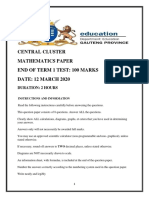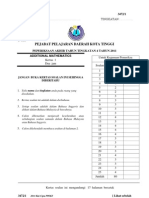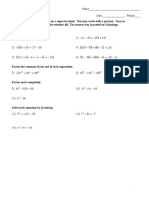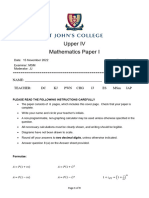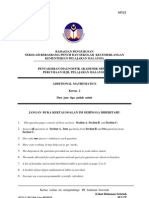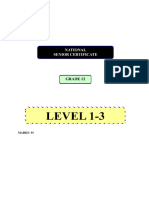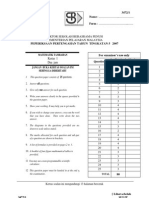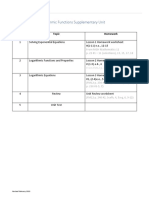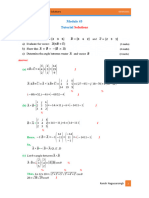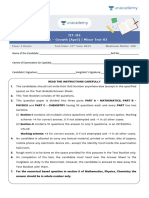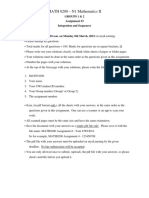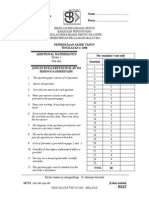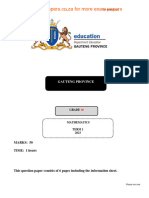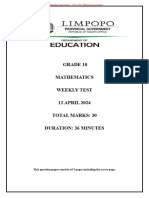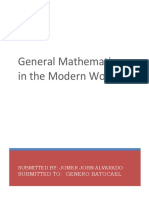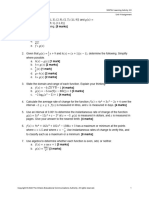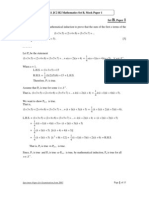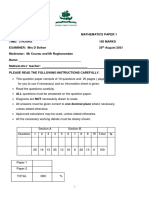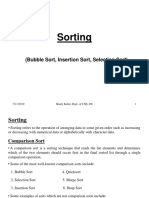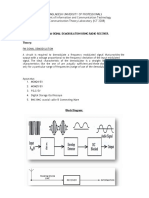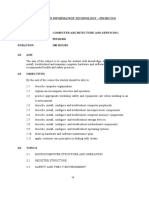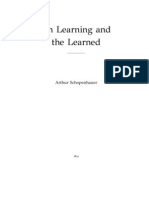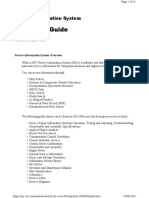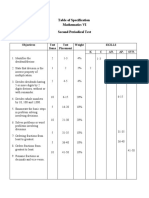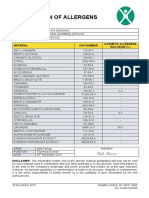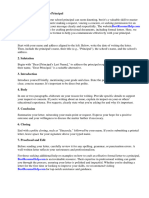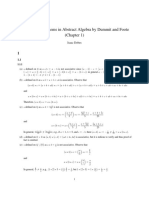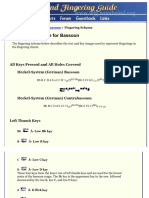Mergesort: 7/11/2019 Mitra Kabir, Dept. of CSE, DU 1
Mergesort: 7/11/2019 Mitra Kabir, Dept. of CSE, DU 1
Uploaded by
Sadia AfreenCopyright:
Available Formats
Mergesort: 7/11/2019 Mitra Kabir, Dept. of CSE, DU 1
Mergesort: 7/11/2019 Mitra Kabir, Dept. of CSE, DU 1
Uploaded by
Sadia AfreenOriginal Title
Copyright
Available Formats
Share this document
Did you find this document useful?
Is this content inappropriate?
Copyright:
Available Formats
Mergesort: 7/11/2019 Mitra Kabir, Dept. of CSE, DU 1
Mergesort: 7/11/2019 Mitra Kabir, Dept. of CSE, DU 1
Uploaded by
Sadia AfreenCopyright:
Available Formats
Mergesort
7/11/2019 Mitra Kabir, Dept. of CSE, DU 1
The Divide-and-Conquer Approach
Two Necessary Steps
1. Divide: Smaller problems are solved recursively.
2. Conquer: The solution of the original problem is formed from the solutions
to the subproblems.
The running time equation of divide and conquer approach:
T(n) = 2T(n/2) + O(n) where n is the input size.
The solution to this equation is O(nlog2n).
7/11/2019 Mitra Kabir, Dept. of CSE, DU 2
Merge Sort
• Merge sort is a comparison sorting technique.
• This technique follows the divide-and-conquer approach.
• It maintains the following 3 steps:
1. Divide: Divide N-element sequence to be sorted into two subsequences of
about N/2 elements each and sort the two subsequences recursively .
2. Conquer: Merge the two sorted subsequences to produce the sorted result.
• Merge sort uses the “merge” step to combine two sorted sublists to create one single
sorted list.
• Suppose A is a sorted list with R elements and B is another sorted list with S elements.
After merging there is only a single sorted list C with N=R+S elements.
7/11/2019 Mitra Kabir, Dept. of CSE, DU 3
Mergesort Algorithm
Merge-Sort(A, Left, Right) Merge(A, Left, Center, Right)
(1) If Left < Right do steps 2 to 5 (1) n1 = Center – Left + 1
(2) n2 = Right – Center
(2) Set Center = (Left+Right)/2
(3) Create arrays L[1…n1] and R[1…n2]
(3) Merge-Sort (A, Left, Center)
(4) For i = 1 to n1
(4) Merge-Sort (A,Center+1, Right)
(5) do L[i] = A[Left + i -1]
(5) Merge(A, Left, Center, Right) (6) For j = 1 to n2
(6) End (7) do R[j] = A[Center + j]
(8) i=1
(9) j=1
(10) For k = Left to Right
(11) do if L[i] <= R[j]
(12) then A[k] = L[i]
(13) i=i+1
(14) else A[k] = R[j]
(15) j=j+1
(16) End
7/11/2019 Mitra Kabir, Dept. of CSE, DU 4
Example:
Suppose Array A = 5, 2, 4, 7, 1, 3, 2, 6. Sort the array using Mergesort.
5 2 4 1 7 3 2 6
5 2 4 1 7 3 2 6
5 2 4 1 7 3 2 6
5 2 4 1 7 3 2 6
2 5 1 4 3 7 2 6
1 2 4 5 2 3 6 7
1 2 2 3 4 5 6 7
7/11/2019 Mitra Kabir, Dept. of CSE, DU 5
Example:
Suppose Array A = 38, 27, 43, 3, 9, 82 and 10. Sort the array using Mergesort.
7/11/2019 Mitra Kabir, Dept. of CSE, DU 6
Complexity of Merge-Sort
Let T(N) be the number of comparisons needed to sort N elements using merge
sort. This algorithm requires at most logN passes. Moreover, each pass merges
a total of N elements and each pass will require at most N comparisons. So, for
all cases, T(N) = 0(NlogN).
Recurrence Relation for Mergesort
T(1) = 1 For N = 1
T(N) = 2T(N/2) + N Otherwise
7/11/2019 Mitra Kabir, Dept. of CSE, DU 7
# T(N) = 2T(N/2) + N is equivalent to O(Nlog2N)
Solution:
T(N) = 2T(N/2) + N
T(N/2) = 2T(N/4) + N/2
T(N/4) = 2T(N/8) + N/4
……………………..
T(2) = 2T(1) + 2
T(N) = 2KT(N/2K) + K.N
By using 2K = N, it is obtained as
T(N) = NT(1) + NLog2N = N + NLog2N = O(NLog2N)
So, T(N) = 2T(N/2) + N is equivalent to O(Nlog2N).
7/11/2019 Mitra Kabir, Dept. of CSE, DU 8
END
7/11/2019 Mitra Kabir, Dept. of CSE, DU 9
You might also like
- Term 1 Controlled Test GR 12 MathematicsDocument9 pagesTerm 1 Controlled Test GR 12 MathematicsMichael AkintolaNo ratings yet
- CST 370 Final ExamDocument7 pagesCST 370 Final ExamJosh JonesNo ratings yet
- ISU - Installation, Meter Reading, Bill Order, Billing, Invoice and Invoice Printing ProcessDocument12 pagesISU - Installation, Meter Reading, Bill Order, Billing, Invoice and Invoice Printing ProcessShammi ManchandaniNo ratings yet
- Dean - The Inka Married The EarthDocument18 pagesDean - The Inka Married The EarthJosé de la MazaNo ratings yet
- MTA Grade 11 June Exam 2022Document6 pagesMTA Grade 11 June Exam 2022matodziraphalalani6No ratings yet
- English Maths p1 QP GR 9 2016Document6 pagesEnglish Maths p1 QP GR 9 2016llewellynslambee12No ratings yet
- Add Maths Final Form 4 2011 P1Document17 pagesAdd Maths Final Form 4 2011 P1Sa'adiah AliNo ratings yet
- Geometry Algebra Review PDFDocument2 pagesGeometry Algebra Review PDFmeenu dNo ratings yet
- June Controlled Test Grade 8 2024 Mokhari Secondary SchoolDocument21 pagesJune Controlled Test Grade 8 2024 Mokhari Secondary Schoolu19003464No ratings yet
- Maths April QP & Memo Gauteng 2021 Gr12Document27 pagesMaths April QP & Memo Gauteng 2021 Gr12Kgalema KgomoNo ratings yet
- GR 11 FS Nov CoreDocument10 pagesGR 11 FS Nov Coresibabalwelengisi095No ratings yet
- B1 Module 1 Lesson 2Document6 pagesB1 Module 1 Lesson 2Dionis DagumanNo ratings yet
- 2022 UIV Nov Paper 1Document9 pages2022 UIV Nov Paper 1Dharshaan GopaulNo ratings yet
- 2015 IEB G10 Maths Nov Paper 1-QPDocument13 pages2015 IEB G10 Maths Nov Paper 1-QPbophelokhethaNo ratings yet
- Percubaan Matematik Tambahan Kertas 2 SPM 2012 (SBP)Document19 pagesPercubaan Matematik Tambahan Kertas 2 SPM 2012 (SBP)Muruli KrishanNo ratings yet
- Mme Even Questions Answer KeyDocument79 pagesMme Even Questions Answer Keysaibhardwaj008No ratings yet
- 1 4 B-Exercises PDFDocument5 pages1 4 B-Exercises PDFFlorey Mae LubianoNo ratings yet
- Level 1-3Document9 pagesLevel 1-3loreallaurie2000No ratings yet
- Daa AllDocument24 pagesDaa AllPoison RemarkNo ratings yet
- Math P1 2015 JuneDocument4 pagesMath P1 2015 Junemizophyll37No ratings yet
- Matrices and DeterminantsDocument2 pagesMatrices and Determinantsvikas aggarwalNo ratings yet
- Kertas 1 Dua Jam: 2 HoursDocument13 pagesKertas 1 Dua Jam: 2 HoursSelvarani NasaratnamNo ratings yet
- Grd8 Maths June 2019Document8 pagesGrd8 Maths June 2019Lehlogonolo MatsimelaNo ratings yet
- Grade 11 Paper 1 MathematicsDocument9 pagesGrade 11 Paper 1 MathematicsMelulekiNo ratings yet
- MCR3U5 - Supplementary Unit (Feb 2020)Document12 pagesMCR3U5 - Supplementary Unit (Feb 2020)Veceslav VladanNo ratings yet
- Grade 12 Maths Test 2Document8 pagesGrade 12 Maths Test 2leebathNo ratings yet
- GR 10 Maths p1 Nov EngDocument6 pagesGR 10 Maths p1 Nov EngkatlehotaurusNo ratings yet
- MATH2013 Module #3 Tutorial SolutionsDocument12 pagesMATH2013 Module #3 Tutorial Solutionsmayqueenslove777No ratings yet
- IIT-JEE Growth Minor Test 3 April 111003 Sol (1)Document30 pagesIIT-JEE Growth Minor Test 3 April 111003 Sol (1)amoghdharane5No ratings yet
- Maths Grade 8 Preparatory Examination May 2019 Paper - 3Document8 pagesMaths Grade 8 Preparatory Examination May 2019 Paper - 3Lehlogonolo MatsimelaNo ratings yet
- ME328MidtermExam1 - Review ProblemsDocument13 pagesME328MidtermExam1 - Review ProblemsHECTOR DANIEL SANCHEZ CASTILLONo ratings yet
- 2024 Mathematics Grade 7 (Mid-Year)Document5 pages2024 Mathematics Grade 7 (Mid-Year)motaungmpho328No ratings yet
- GR 11 P2 June 2023 Final (2) - 1Document16 pagesGR 11 P2 June 2023 Final (2) - 1Bongie NgamlanaNo ratings yet
- MATH 0200 - Assignment 3Document2 pagesMATH 0200 - Assignment 3Lydia BoucherNo ratings yet
- Add MTH f4 Final SBP 2008Document43 pagesAdd MTH f4 Final SBP 2008Mugilan GanesanNo ratings yet
- Kajang 2011 (P1) PDFDocument13 pagesKajang 2011 (P1) PDFVIPscholarNo ratings yet
- Nov Exam Gr9 Paper 1Document10 pagesNov Exam Gr9 Paper 1avelakhanyile9No ratings yet
- Unit Dimension and Measurement (Ques Bank)Document7 pagesUnit Dimension and Measurement (Ques Bank)Om GoyalNo ratings yet
- GR 10 Mathematics (English) Term 1 Test 2023 Question PaperDocument6 pagesGR 10 Mathematics (English) Term 1 Test 2023 Question PaperlehulalethokuhleNo ratings yet
- Observations On The Ternary Cubic Equation: S.Vidhyalakshmi, M.A.Gopalan, A.KavithaDocument6 pagesObservations On The Ternary Cubic Equation: S.Vidhyalakshmi, M.A.Gopalan, A.KavithaInternational Journal of computational Engineering research (IJCER)No ratings yet
- Maths Grade 11 P1 Second Push 2023Document6 pagesMaths Grade 11 P1 Second Push 2023elepeachs100% (2)
- Mathongo Jee Main 2017Document31 pagesMathongo Jee Main 2017sai mukeshNo ratings yet
- PHP J1 XRG IDocument40 pagesPHP J1 XRG Isunitadevi1986kNo ratings yet
- Math GR 10 Weekly Test 12 April 2024Document5 pagesMath GR 10 Weekly Test 12 April 2024lesaoanajoy3No ratings yet
- Grade 11 Term 1 - 2023Document5 pagesGrade 11 Term 1 - 2023lesegomugodiNo ratings yet
- General Mathematics in The Modern World: Submitted To: Genero BatocaelDocument14 pagesGeneral Mathematics in The Modern World: Submitted To: Genero BatocaelJoh Na AlvaradoNo ratings yet
- Chain RuleDocument11 pagesChain RuleJhiela Mae MacaraigNo ratings yet
- 2018 NW Mathematics-GR-11-P1 QPDocument6 pages2018 NW Mathematics-GR-11-P1 QPTshire ʚĭɞNo ratings yet
- Screenshot 2024-05-27 at 5.21.32 PMDocument2 pagesScreenshot 2024-05-27 at 5.21.32 PMyarabay206No ratings yet
- 1st Lesson EconometricsDocument21 pages1st Lesson Econometricsjovanamarceta89No ratings yet
- Topical Questions 1Document4 pagesTopical Questions 1I just want subscribers plsNo ratings yet
- Maths p1 Final Exams 2023Document7 pagesMaths p1 Final Exams 2023opholaonikaNo ratings yet
- Functions Assignment - Composite FunctionDocument2 pagesFunctions Assignment - Composite FunctionxcodafatherNo ratings yet
- Maths March Grade 11 QP & MemoDocument18 pagesMaths March Grade 11 QP & Memomakhensa345No ratings yet
- 2019 Grade 12 Math Trial Exam Paper 1 WC MNDocument11 pages2019 Grade 12 Math Trial Exam Paper 1 WC MNafrika.entshoNo ratings yet
- Converting Improper Fractions To Mixed NumbersDocument2 pagesConverting Improper Fractions To Mixed NumbersJanice ChavezNo ratings yet
- LP Maths Grade 8 June 2024 QP and MemoDocument14 pagesLP Maths Grade 8 June 2024 QP and Memoalwandebuthelezi59No ratings yet
- 2011 Set B Mock Paper 1 SolutionsDocument15 pages2011 Set B Mock Paper 1 SolutionsJordan TiongNo ratings yet
- Trials Examination 2021mathematics Paper 1Document20 pagesTrials Examination 2021mathematics Paper 1Wessel PretoriusNo ratings yet
- Quicksort: 7/11/2019 Mitra Kabir, Dept. of CSE, DU 1Document27 pagesQuicksort: 7/11/2019 Mitra Kabir, Dept. of CSE, DU 1Sadia AfreenNo ratings yet
- Lec-3 Sorting (Bubble, Insertion, Selection)Document13 pagesLec-3 Sorting (Bubble, Insertion, Selection)Sadia AfreenNo ratings yet
- Bangladesh University of Professionals Department of Information and Communication Technology Course No.: Communication Theory Laboratory (ICT 2208)Document2 pagesBangladesh University of Professionals Department of Information and Communication Technology Course No.: Communication Theory Laboratory (ICT 2208)Sadia AfreenNo ratings yet
- Predicting Depression Levels Using Social Media Posts: AbstractDocument4 pagesPredicting Depression Levels Using Social Media Posts: AbstractSadia AfreenNo ratings yet
- Lakshmisha ResumeDocument3 pagesLakshmisha ResumeLakshmisha.R.A. Lakshmisha.R.A.No ratings yet
- Cole and Scribner StudyDocument6 pagesCole and Scribner Studyisaacwong620No ratings yet
- 2008 Issue 2 - Who Really Owns The Holy Land? - Counsel of ChalcedonDocument6 pages2008 Issue 2 - Who Really Owns The Holy Land? - Counsel of ChalcedonChalcedon Presbyterian ChurchNo ratings yet
- ND Syllaby 6 SubjectsDocument29 pagesND Syllaby 6 SubjectsPreston KhumbulaNo ratings yet
- Eapp Lesson 8Document36 pagesEapp Lesson 8ghella2006No ratings yet
- A8 FilesDocument2 pagesA8 Fileskrishiv7734No ratings yet
- Resolution Part-1: Dr. Abdelaziz SaidDocument44 pagesResolution Part-1: Dr. Abdelaziz SaidMohamed FassalNo ratings yet
- Schopenhauer - 'On Learning and The Learned'Document13 pagesSchopenhauer - 'On Learning and The Learned'Benjamin Horvath100% (1)
- Scrabble Guidelines and Mechanics Final 1Document4 pagesScrabble Guidelines and Mechanics Final 1Ali IsaacNo ratings yet
- ISJ1K3 - ENGLISH II - Lecture Note 10 THESIS-LSKDocument24 pagesISJ1K3 - ENGLISH II - Lecture Note 10 THESIS-LSKReyza Agung DNo ratings yet
- Literary AnalysisDocument16 pagesLiterary AnalysisPearl Hazel Neri Camargo100% (2)
- Life Vision A1-A2 - Unit 1 - Original - RecuperaçãoDocument6 pagesLife Vision A1-A2 - Unit 1 - Original - RecuperaçãoLigiane Ferreira PortoNo ratings yet
- Worksheet Final EdDocument3 pagesWorksheet Final EdOscarNo ratings yet
- SIS User's Guide: Service Information SystemDocument31 pagesSIS User's Guide: Service Information SystemKeith McCannNo ratings yet
- Frankenstein ParagraphDocument1 pageFrankenstein ParagraphfzahraalimehdiNo ratings yet
- Mock TestDocument4 pagesMock TestthuynyzhongliNo ratings yet
- PT - Mathematics 6 - Q2Document5 pagesPT - Mathematics 6 - Q2Geornie SomohidNo ratings yet
- Declaration of Allergens: Material Cas Number Cosmetic Allergens Inclusion (%)Document1 pageDeclaration of Allergens: Material Cas Number Cosmetic Allergens Inclusion (%)pujiNo ratings yet
- Formal Letter Format To PrincipalDocument4 pagesFormal Letter Format To Principalkqosmkjbf100% (2)
- Task Response 6.0: Requirements of The Task Position Main IdeasDocument5 pagesTask Response 6.0: Requirements of The Task Position Main IdeasYiwei LiNo ratings yet
- Favor Declarations - People of Prophetic Power MinistriesDocument3 pagesFavor Declarations - People of Prophetic Power MinistriesOlajumoke TabitiNo ratings yet
- 166.ANJ.12 Formal and Informal LettersDocument18 pages166.ANJ.12 Formal and Informal LettersChichi MounaNo ratings yet
- DF Chapter 1 SolutionsDocument37 pagesDF Chapter 1 SolutionsLearn MathematicsNo ratings yet
- MATH UNIT 1 LESSON 32 EditedDocument23 pagesMATH UNIT 1 LESSON 32 EditedAlyssa Montereal MarceloNo ratings yet
- English: Department of EducationDocument16 pagesEnglish: Department of EducationMerrilyn Ababa-SanJuanNo ratings yet
- John Keats 1795-1821: "They Will Explain Themselves - As All Poems Should Do Without Any Comment."Document89 pagesJohn Keats 1795-1821: "They Will Explain Themselves - As All Poems Should Do Without Any Comment."Noor UlainNo ratings yet
- Bassoon Fingering PDFDocument42 pagesBassoon Fingering PDFAlfonso VallettaNo ratings yet
- Gerund/ Infinitive Worksheet 1: What Is A Gerund?Document6 pagesGerund/ Infinitive Worksheet 1: What Is A Gerund?Sameer MiguelNo ratings yet
